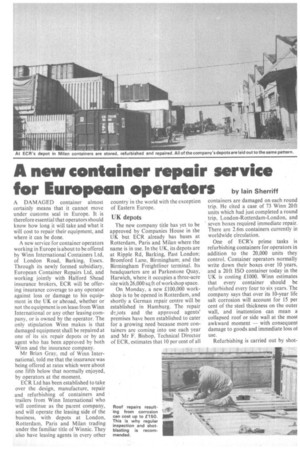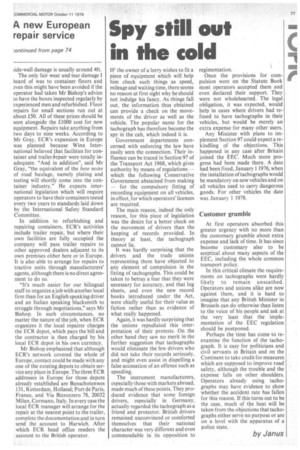A new container repair service
Page 75

Page 76

Page 79

If you've noticed an error in this article please click here to report it so we can fix it.
for European operators by lain Sherriff A DAMAGED container almost certainly means that it cannot move under customs seal in Europe. It is therefore essential that operators should know how long it will take and what it will cost to repair their equipment, and where it can be done.
A new service for container operators working in Europe is about to be offered by Winn International Containers Ltd, of London Road, Barking, Essex. Through its newly formed subsidiary, European Container Repairs Ltd, and working jointly with Halford Shead insurance brokers, ECR will be offering insurance coverage to any operator against loss or damage to his equipment in the UK or abroad, whether or not the equipment is on lease from Winn International or any other leasing company, or is owned by the operator. The only stipulation Winn makes is that damaged equipment shall be repaired at one of its six repair depots or by an agent who has been approved by both Winn and the insurance company.
Mr Brian Gray, md of Winn International, told me that the insurance was being offered at rates which were about one fifth below that normally enjoyed, by operators at the moment.
ECR Ltd has been established to take over the design, manufacture, repair and refurbishing of containers and trailers from Winn International who will continue as the parent company, and will operate the leasing side of the business, with depots at London, Rotterdam, Paris and Milan trading under the familiar title of Winnic. They also have leasing agents in every other country in the world with the exception of Eastern Europe.
UK depots
The new company title has yet to be approved by Companies House in the UK but ECR already has bases at Rotterdam, Paris and Milan where the name is in use. In the UK, its depots are at Ripple Rd, Barking, Past London; Bromford Lane, Birmingham; and the Birmingham Freightliner terminal. Its headquarters are at Parkestone Quay, Harwich, where it occupies a three-acre site with 26,000 sq ft of workshop space.
On Monday, a new £100,000 workshop is to be opened in Rotterdam, and shortly a German repair centre will be established in Hamburg. The repair oi?.?ots and the approved agents' premises have been established to cater for a growing need because more containers are coming into use each year and Mr F. Bishop, Technical Director of ECR, estimates that 10 per cent of all containers are damaged on each round trip. He cited a case of 73 Winn 20ft units which had just completed a round trip, London-Rotterdam-London, and seven boxes required immediate repair. There are 2.6m containers currently in worldwide circulation.
One of ECR's prime tasks is refurbishing containers for operators in addition to the 20,000 units they control. Container operators normally write down their boxes over 10 years, and a 20ft ISO container today in the UK is costing £1000. Winn estimates that every container should be refurbished every four to six years. The company says that over its 10-year life salt corrosion will account for 15 per cent of the steel thickness on the outer wall, and inattention can mean a collapsed roof or side wall at the most awkward moment — with consequent damage to goods and immediate loss of use.
Refurbishing is carried out by shot blasting the exterior side walls, roofs and bulkheads to the Swedish 2.5 standard. In layman's terms this means that the outer skin is removed well below the depth of the corrosion and the surface is left in a rough matt condition so that it can accept priming and painting. The underside of the box is swept with shotbiast and then lightly sprayed with bitumastic paint. The sides of the container are painted to a depth of 85 microns, the corners and roof to a depth of 130 microns.
Damage repairs apart, the standard rate for refurbishing at ECR's depots or agents is £140 sterling. However, Mr Bishop pointed out that fluctuations in currency exchange could take the figure £10 either way. Damage repair costs are charged in addition.
Provided regular inspection is carried out, container refurbishing is something which can be programmed while the unit is still in operation. The box can be used to carry goods between terminals and refurbished after the load has been discharged, thus causing minimal disruption of traffic flow. ECR's repair bases are as close to load transfer points as possible and in some cases are actually within the transfer terminals.
ECR estimates that if containers are not refurbished shortly after their fourth year, then their life expectancy will be reduced to not more than seven years.
Trailers, too
In addition to refurbishing containers, ECR repairs both containers and trailers, and Mr Bishop pointed out that whereas in the early days of containers, local blacksmiths were well enough skilled and equipped to carry out repairs to the simply constructed boxes, their more sophisticated and expensive 1974 counterparts require a much more professional approach. He estimates that the cost of container repair in the UK alone is now well over £4m a year, and for Europe the figure exceeds £20m a year.
Repair companies in Europe, he said, fall into two categories, large single units with all the operation based at one point and close to a port, or, as with ECR, a number of smaller self-supporting units forming a European network but responsible to one central point. The large single units have a constant market drawn from the major shipping companies, many of whom have a financial interest in the repairer, whereas the network of smaller repairers builds up its business from leasing companies and forwarders who need facilities at inland depots, rather than at ports.
ECR has found that its repairs fall into two main categories: damage to boxes in transit is sustained by bad crane operation on the dock or stowage on the ship which causes movement in rough sea conditions, but more containers are damaged when they are on a road vehicle than at any other time. Damage in transit by road occurs mainly at low bridges, Or when twist locks have not been used or have been improperly secured, when the containers have been mounted on unsuitable vehicles with marginally insufficient floor space, when travelling empty and exposed to high cross-winds, am during an accident involving the vehicle The low-bridge hazard increased witl the introduction of the 8ft bin high con tamer. Drivers who had for many year operated, safely with the standard 8f container failed to recognize the -extrl 6in and did not appreciate that familia bridges which at one time gave them 6ii clearance were then just low enough tc take the top off a box. The other, mair area of damage is caused by box dis tortion and the carriage of corrosiv( materials which creates excessive rust ing.
ECR advises all operators to ensur( that their drivers know the dimension: of their vehicle and load, and that the check all routes carefully, thus eliminat ing the low bridge hazard. Leaving it tc chance could mean upwards of £30( worth of damage. The compan3 strongly advises regular inspection anc maintenance, and says that points tc watch for are the rubber door gaskets door hinges and floor wear. Mr Bishop pointed out that it followed almost automatically that if a container was damaged then the profile would cer. tainly not comply with customs and ISC requirements, so the vehicle could noi be used to carry goods until repaired.
The ECR service, says Mr Bishop, is designed to cater for even the smallest, inexperienced and most remote operator, whether he is based in the UK or any other part of Europe. In addition to their own language, the management of ECR's major European depots all speak English, and when a driver is quoted for a repair, the figure is quoted in English.
"If you tell a driver that a repair job in Milan is to cost 50,000 lira, he has hardly enough strength left to transmit the figure back to his manager in the UK. Unless the boss is absolutely conversant with the rate of exchange, he is likely to have a coronary", he said, "so our managers quote the figure in sterling, and undoubtedly £30 sounds much more sensible."
New roof
The most common types of repair job carried out by ECR are roof replacement at about £150, and it costs almost as much to replace a damaged corner post. Damaged doors and door locking gear are probably the most common repair, and Mr Bishop says that such damage is usually caused by the driver neglecting to fasten the doors back when the load is being discharged. This negligence can cost £200 and more. A damaged side costs around £10 per foot to repair so that if a 20ft container is pierced along its entire length, it is a £200 repair job. But the most common ;ide-wall damage is usually around 411.
The only fair wear and tear damage I heard of was to container floors and even this might have been avoided if the Dperator had taken Mr Bishop's advice to have the boxes inspected regularly by experienced men and refurbished. Floor repairs for small sections run out at about £50. All of these prices should be seen alongside the £1000 cost for new equipment. Repairs take anything from two days to nine weeks. According to Mr Gray, ECR's expansion in Europe was planned because Winn International believed that facilities for container and trailerkepair were totally inadequate. "And in addition", said Mr Gray, "the equivalent of the bete noire of road haulage, namely plating and testing will shortly come into the container industry." He expects international legislation which will require operators to have their containers tested every two years to standards laid down by the International Safety Standard Committee.
In addition to refurbishing and repairing containers, ECR's activities include trailer repair, but where their own facilities are fully occupied the company will pass trailer repairs to other approved dealers adjacent to its own premises either here or in Europe. It is also able to arrange for repairs to tractive units through manufacturers' agents, although there is no direct agreement to do so.
"It's much easier for our bilingual staff to organize a job with another local firm than for an English speaking driver and an Italian speaking blacksmith to struggle through negotiations," says Mr Bishop. In such circumstances, no matter the nature of the job, when ECR organizes it the local repairer charges the ECR depot, which pays the bill and the contractor is then charged by his local ECR depot in his own currency.
Mr Bishop emphasized that although ECR's network covered the whole of Europe, contact could be made with any one of the existing depots to obtain service any place in Europe. The three ECR addresses in Europe for those depots already established are Bunschotenwes 131, Rotterdam, Holland; Port de Paris, France, and Via Bizzozzero 78, 20032 Milan, Co rmano, Italy. In every case the local ECR manager will arrange for the repair at the nearest point to the trailer, complete the documentation and in turn send the account to Harwich. After which ECR head office renders the account to the British operator.




























































































































































